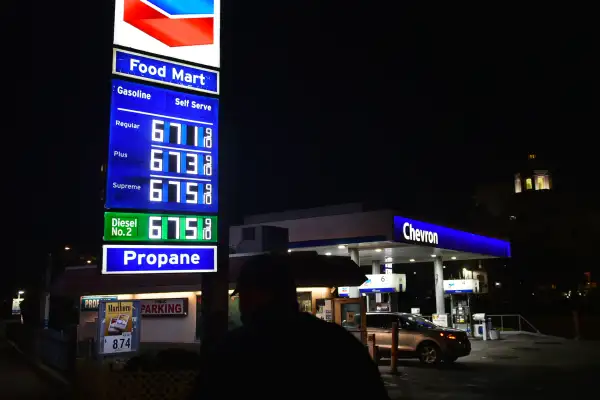Gas Prices Just Passed $6 in a Major U.S. City for the First Time Ever

Gas prices may be dropping from recent record highs in most of the country — but it's a different story in much of the West Coast. Fuel prices are still rising in Nevada and California, and, for the first time ever, the average gallon of regular gasoline now costs over $6 in a major U.S. city.
That city, unsurprisingly, is in California. It's Los Angeles, where the average gallon of regular gas cost $6.01 as of Tuesday, up from $5.84 one week before, according to AAA. Average gas prices have also surpassed $6 in a few other parts of California, including the San Luis Obispo area and Inyo and Mono counties, along the Nevada border.
While California is notorious for high gas prices, largely due to a range of special regulations and taxes, many drivers are shocked at how quickly fuel costs have soared. Not even three weeks ago, we were marveling at how gas prices had crossed the $5-a-gallon mark in California cities for the first time ever.
Now, we've blown past that.
As for California as a whole, gas prices have hit $5.87 on average, up from $5.75 last week and $3.88 one year ago. That's right: Average gas prices in the Golden State are just about $2 higher than they were 12 months ago.
In neighboring Nevada, gas prices are averaging $5.14 per gallon compared to $4.96 a week ago. Regular gasoline in the Las Vegas metro area costs an average of $5.22, representing an increase of 24 cents in one week and $1.92 over the past year.
For the most part, drivers in the rest of the U.S. have been experiencing slight relief at the pump. The national average is down to $4.24 per gallon of regular, down from $4.32 a week ago. But overall, prices remain abnormally high: Across the nation, gas prices were $3.53 a month ago and $2.88 a year ago, on average.
Drivers today in at least 33 states are still paying over $4 a gallon for the average gallon of gas.
While some drivers may assume gas stations are guilty of price gouging, consumer prices for gas are based mostly on global crude oil markets. According to the U.S. Energy Information Administration, crude oil prices are responsible for 61% of what a gallon of gas costs. The rest of what you pay at the pump stems from refinery costs, taxes, and distribution and marketing.
During the latter half of 2021, wholesale crude oil prices rose because of a mixture of heightened demand and diminished supply stemming back to the early months of the pandemic, when oil companies scaled back production dramatically. Russia is a major oil producer, and the global tensions over its invasion of Ukraine have pushed oil prices significantly higher still.
Brent crude oil futures, a benchmark for global oil prices, cost roughly $75 a barrel in December. They then spiked to around $130 in early March before settling back in the range of $105 to $115 recently.
States know that drivers are hurting, and several are taking steps to give them a break by temporarily eliminating gas taxes. Many states are also trying to ease the burden of high inflation in general by slashing other taxes, including those on groceries, income and real estate.
Want to take matters into your own hands? There are plenty of measures individual drivers can take to trim gasoline expenses. Check out our guide for how to save money on gas for the best strategies.
More from Money:
Your State Taxes on Groceries, Income, Gas and More Could Soon Be Slashed
